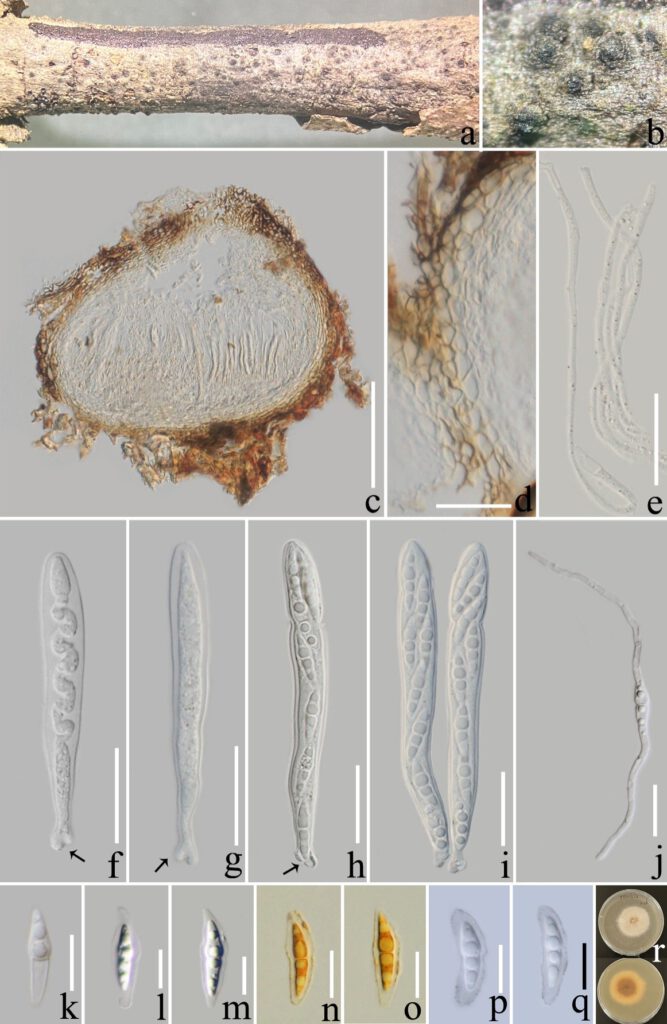Pseudocoleophoma yunnanensis L. Lu, K.D. Hyde & Tibpromma, sp.nov. (Figure 3)
MycoBank number: MB; Index Fungorum number: IF; Facesoffungi number: FoF 12762;
Etymology: Name reflects the location Yunnan Province, where the holotype was collected.
Holotype: ZHKU 22-0116
Saprobic on decaying branch of Coffea sp. Sexual morph: Ascomata 160–280 µm high × 200–280 µm diam (x̅ = 216 × 243 µm; n = 15), semi-immersed to erumpent, solitary or scattered, coriaceous, subglobose to obpyriform, dark brown to black, with protruding ostiolar neck. Peridium 22–27 µm wide (x̅ = 23; n = 15), outer walls comprising 2–4 layers of textura angularis cells, hyaline to brown, inner walls hyaline, density, several layers of textura angularis cells. Hamathecium 1.5–3 µm wide (x̅ = 2.1 μm; n = 15), hyaline, septate, branched, pseudoparaphyses numerous. Asci 65–90 × 8–11 µm (x̅ = 76 × 9 µm; n = 20), 8-spored, fissitunicate, clavate to cylindrical, some slightly curved, with an ocular chamber, short-stalked with club-shape pedicel. Ascospores 16–26 × 4–8 (x̅ = 21 × 6 µm; n = 20), uni to biseriate, hyaline, fusiform, straight to slightly curved, 1-septate, 4 guttulate, smooth-walled, with distinct sheath. Asexual morph: Not observed.
Culture characteristics: Ascospores germinated on PDA within 12 hours, colonies on PDA after two months attaining a diam of 40 mm at 25 °C, slightly raised, fluffy, white, circular, margin filamentous, reverse pale yellow to light brown from edge to center.
Material examined: China, Yunnan Province, Jinghong city, on decaying branch of Coffea sp., (1672 m), 12 September 2021, LiLu, JHMH 15 (ZHKU 22-0116, holotype), ZHKUCC 22-0200 = ZHKUCC 22-0201. GenBank number; ITS: ***, LSU: ***, SSU: ***, tef1-α: *** (ZHKUCC 22-0200, ex-type); ITS: ***, LSU: ***, SSU: ***, tef1-α: *** (ZHKUCC 22-0201).
Notes: In the phylogenetic tree, our species Pseudocoleophoma yunnanensis formed a well-separated clade clustered with Pse. bauhiniae (MFLUCC 17-2280) with high statistical support (90% ML/1.00 BYPP, Figure 1). Based on nucleotide comparisons, our isolate (ZHKUCC 22-0200) is different from Pse. bauhiniae (MFLUCC 17-2280) by 13/489 bp (2.6%) in ITS, 3/833 bp (0.4%) in LSU, 9/1069 bp (0.8%) in SSU, and 73/878bp (8.3%) in tef1-α. In addition, morphological features of the sexual morph Pse. yunnanensis can be distinguished by having bigger ascomata and the presence of a distinct sheath of ascospores [47]. Therefore, we introduce Pse. yunnanensis as a new species that was isolated from coffee.

Figure 3. Pseudocoleophoma yunnanensis (ZHKU 22-0116). (a–b) Ascomata on a decayed branch of Coffea sp.; (c) Section of an ascoma; (d) Peridium at side; (e) Pseudoparaphyses; (f–i) Immature and mature asci, arrows indicate club-shape pedicel; (j) Germinated ascospore; (k–m) Ascospores; (n,o) Ascospore stained with Lugol’s iodine; (p,q) Ascospore stained with Indian ink; (r) Colony grow on PDA. Scale bars: (c) = 100 µm; (d–j) = 20 µm; (k–q) = 10 µm.
